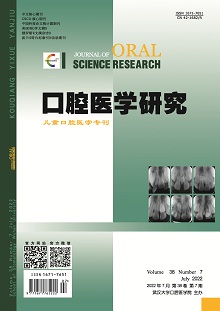|
|
Effects of Preheating on Marginal Microleakage of Resin Composite Filled Pit and Fissure Caries Measured with Intraoral Scanner
YU Fan, LV Changhai, MA Xueting, FU Lilin, RAO Nanquan, LIU Bo
2022, 38(7):
659-665.
DOI: 10.13701/j.cnki.kqyxyj.2022.07.016
Objective: To explore the effect of preheating on the marginal microleakage of 3M Z350 XT universal resin in the treatment of dental caries with different widths with the assistance of intraoral scanner. Methods: Fifty-one human permanent molars were collected. The roots of teeth were cut off, and the crowns were split from mesial side to distal side, departing into buccal piece and lingual/palatal piece. One hundred and two samples were randomly divided into 6 groups (n=17). L-shaped cavities with different widths were prepared on samples to simulate natural pits and fissures [the length of cavity was (4.0±0.5) mm, the depth was 2 mm, and the widths were 1 mm, 1.6 mm, and 2 mm, respectively]. The mark was made on the bur before the preparation to determine the depth of the cavity, the different burs were used to roughly measure the width and length of the cavity during the preparation. After the completion, the cavities in three dimensions were measured by TRIOS digital scanner. Only qualified samples were selected. The width of cavities in group A1, A2, and A3 were filled with room temperature Z350 XT universal resin composite, and in group B1, B2 and B3 were filled with 60℃ Z350 XT universal resin composite. All the samples were subjected to thermocycling. Sixteen samples randomly selected from each group were used to dye in 1% methylene blue solution for 24 h and to detect the extent of marginal microleakage quantitatively, while other samples were used for SEM observation. Results: There was no significant differences in the width, length, and depth of the cavities between the room temperature and preheating groups when the cavity was the same width (P>0.05). There was no significant difference between the preheating and non-preheating groups when filling the 1 mm-wide cavity (P>0.05). When filling the 1.6 mm-wide cavity, the degree of microleakage in the preheating group was lower than that in the non-preheating group at both site 1 and site 2 (P<0.05). When filling the 2 mm-wide cavity, although there was no significant difference between the preheating and non-preheating groups at site 1 (P>0.05), the non-preheating group showed more microleakage values compared to the preheating group at site 2 (P>0.05). SEM observation showed that the bonding interface became more compact in the preheating groups compared to the non-preheating groups, when filling the cavities with 1.6 mm and 2 mm width. Conclusion: Digital intraoral scanner has certain advantages to precisely measure the cavities in three dimensional directions. Preheating technology can reduce the marginal microleakage of resin composite. For pit and fissure caries with the width equal to or narrower than 2 mm, 60℃ Z350 universal resin composite is more suitable for filling the cavities with 1.6-2 mm width, especially for the cavities with complex morphology.
References |
Related Articles |
Metrics
|

